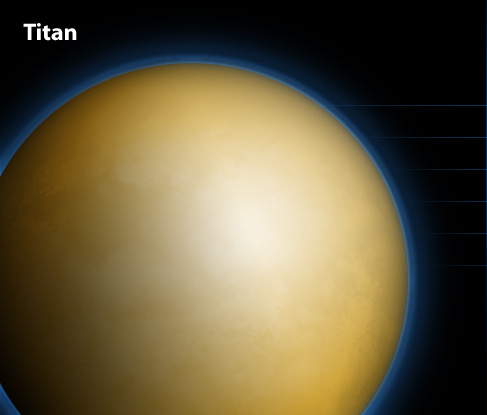Titan
In many respects, Saturn's largest moon, Titan, is one of the most Earth-like worlds we have found to date. With its thick atmosphere and organic-rich chemistry, Titan resembles a frozen version of Earth, several billion years ago, before life began pumping oxygen into our atmosphere.
Titan is of great interest to scientists because it has a substantial, active atmosphere and complex, Earth-like processes that shape its surface. The moon is enveloped by an orange haze of naturally produced photochemical smog that frustratingly obscured its surface prior to Cassini's arrival. Since 2004, the spacecraft's observations have taken the study of this unique world into a whole new dimension.
Cassini has revealed that Titan's surface is shaped by rivers and lakes of liquid ethane and methane (the main component of natural gas), which forms clouds and occasionally rains from the sky as water does on Earth. Winds sculpt vast regions of dark, hydrocarbon-rich dunes that girdle the moon's equator and low latitudes. Volcanism may occur as well, but with liquid water as the lava.
On its journey to Saturn, Cassini carried the European-built Huygens probe. On Jan. 14, 2005, Huygens achieved humankind's first landing on a body in the Outer Solar System when it parachuted through Titan's murky skies. Huygens took measurements of atmospheric composition and wind speeds during its decent, along with an incredible series of images showing telltale patterns of erosion by flowing liquid. The probe came to rest on what appeared to be a floodplain, surrounded by rounded cobbles of water ice.
As the Cassini Mission progresses, the spacecraft will monitor Titan's atmosphere and surface for signs of seasonal change. The spacecraft's radar and camera systems will continue to peer through the haze, expanding our high resolution maps of the surface. And scientists will eagerly await new data that could confirm the presence of a liquid ocean beneath the giant moon's surface.
The exploration of this amazing place is just beginning. Frigid and alien, yet also remarkably similar to our own planet, Titan is a new world – revealed before our very eyes by the Cassini and Huygens spacecraft.
See the Latest Named Features -- updated periodically
|



